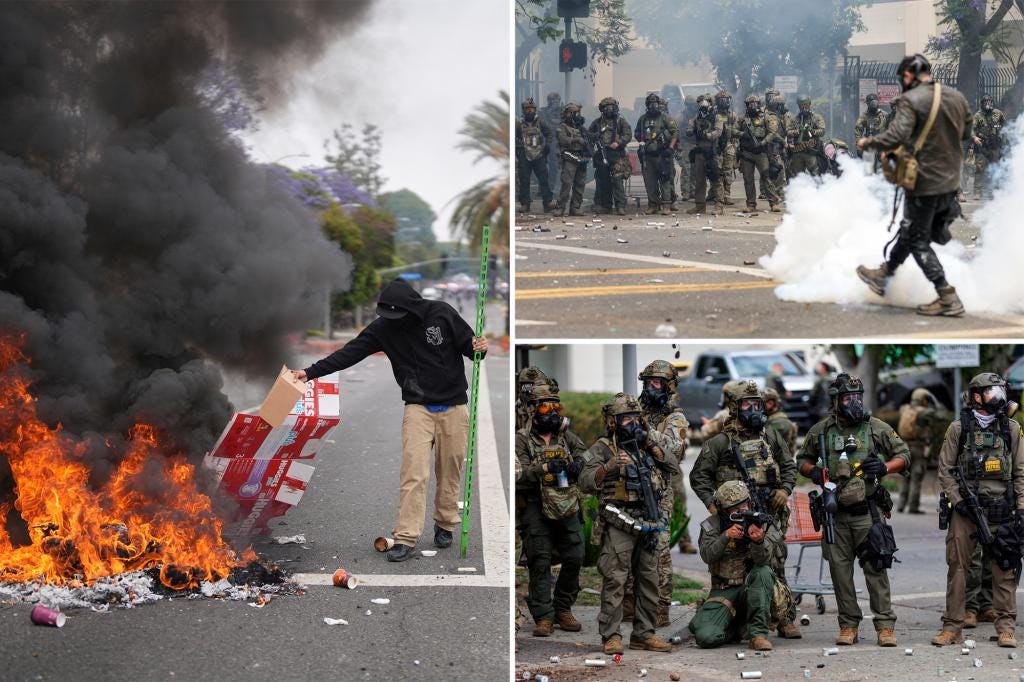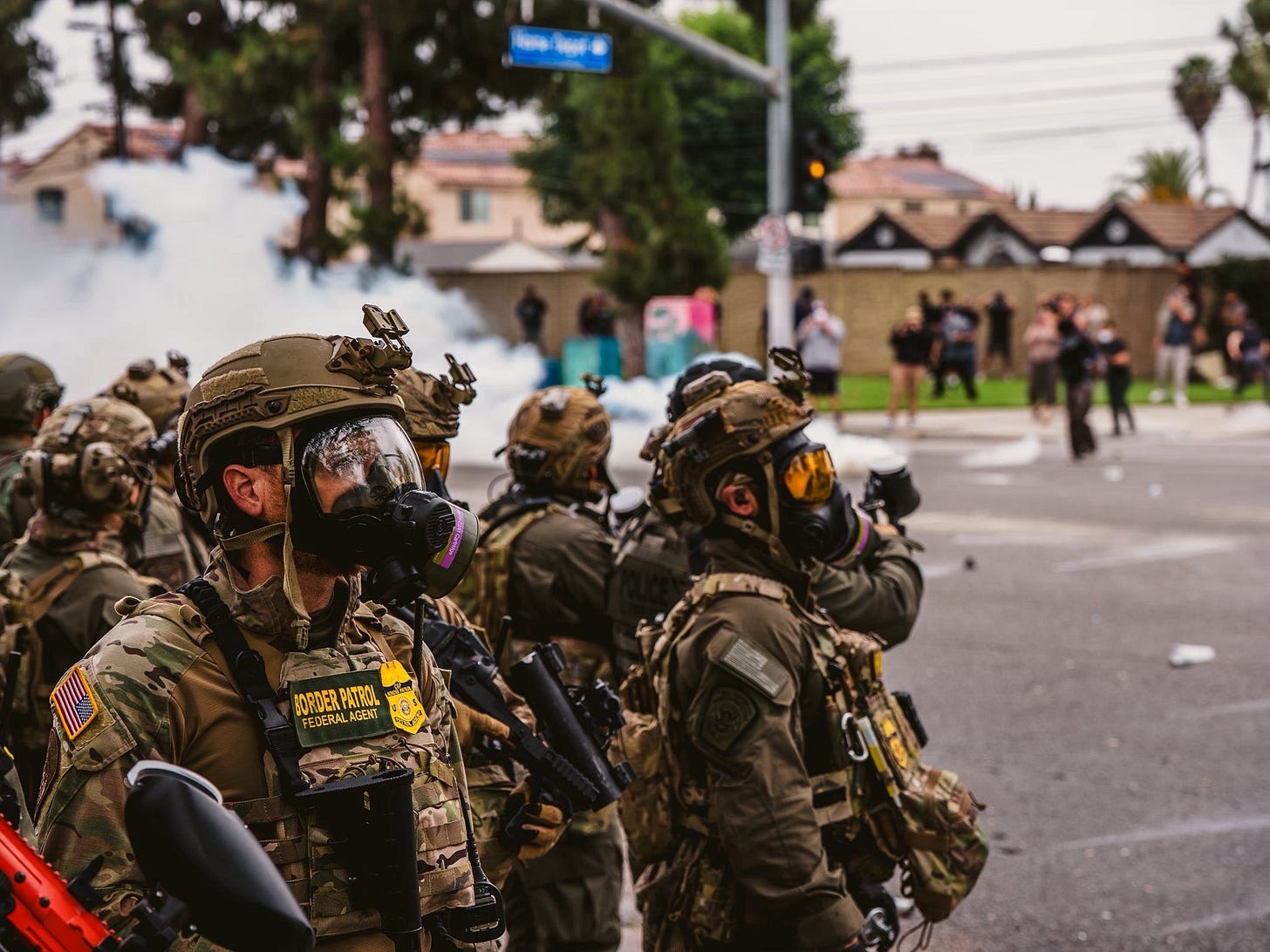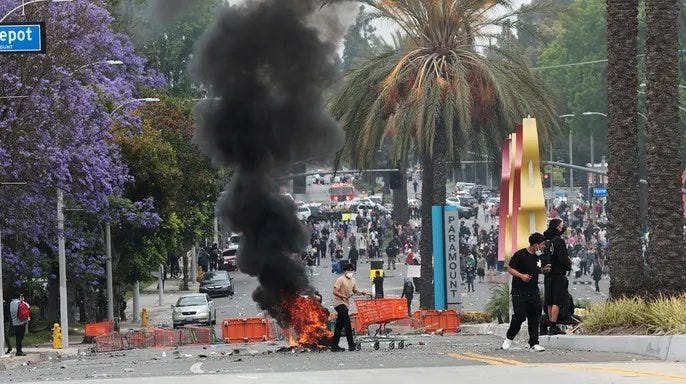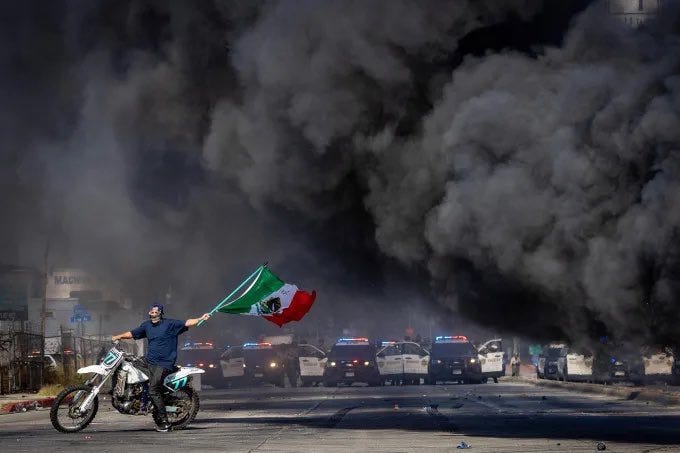Video Reporting by Cam Higby | America First @camhigby
LA rioters are now installing their own street defenses against the police, stretching chicken wire across the road.
She was #2 on the board of the CIA's top cut-out. She was on oversight of the CIA's top cut-out in Congress. She was part of the top CIA cut-out's "network of networks" program. And she's backing the illegal immigrant / cartel network used by our CIA in LatAm as they riot in LA - Who is Karen Bass
The ICE raids in Los Angeles sparked widespread protests that drew hundreds of demonstrators to federal buildings and resulted in multiple arrests. Behind these rapid-response mobilizations stands a sophisticated funding ecosystem that has developed over decades, channeling millions of dollars from major foundations, government sources, and grassroots donations into immigration advocacy and protest support networks.
Recent events demonstrate the scale of this infrastructure. On June 6-7, 2025, when ICE arrested 44 people across three Los Angeles locations, established organizations like the Coalition for Humane Immigrant Rights (CHIRLA) and the National Day Laborer Organizing Network (NDLON) immediately activated rapid response protocols. The protests that followed initially peaceful gatherings that escalated when police declared unlawful assemblies revealed a well-coordinated support system capable of mobilizing legal observers, bail funds, and hundreds of protesters within hours.
The Los Angeles Rapid Response Network (LARRN), founded in 2006, serves as the central coordinating hub for this infrastructure. Operating a 24/7 hotline and comprising over 25 organizations, LARRN represents a coalition that includes immigrant rights groups, labor unions, legal organizations, and faith-based communities. When ICE raids occur, this network can rapidly deploy attorneys, legal observers, and community organizers to detention sites and federal buildings.
Foundation funding drives long-term operations
The financial backbone of this activism comes primarily from major foundations that have invested hundreds of millions of dollars in immigration advocacy over the past decade. The Ford Foundation's BUILD program allocates $2 billion toward immigrant rights initiatives, including a $750,000 grant to UCLA's Institute for Immigration, Globalization, and Education in 2024. Ford originally funded CHIRLA's founding in 1986 and continues supporting the organization's operations.
Open Society Foundations, funded by George Soros, represents one of the largest private sources of immigration advocacy funding globally. With over $23 billion in total expenditures since 1993, Open Society has provided substantial support to organizations like the ACLU, Immigration Equality, and various investigative journalism outlets covering immigration issues. The foundation's funding strategy includes both direct grants and support through intermediary organizations like the Tides Foundation.
The Rockefeller Foundation has provided significant emergency funding for immigration advocacy, including $500,000 each to the ACLU Foundation, International Rescue Committee, and Anti-Defamation League in 2017. Recent grants include $1 million to the National Immigration Law Center for the Protecting Immigrant Families Campaign (2021-2022) and $350,000 for COVID-19 relief for immigrants (2020-2021).
Research reveals that between 2014-2016, just eleven foundations provided half of all pro-immigrant movement funding. These include NEO Philanthropy, Carnegie Corporation of New York, The JPB Foundation, Silicon Valley Community Foundation, and others. However, this represents barely 1% of total foundation funding from the 1,000 largest U.S. foundations, increasing to 1.8% during 2016-2020.
Government funding creates additional revenue streams
Ironically, government agencies also fund organizations that oppose ICE enforcement. CHIRLA reported $18.4 million in revenue for 2021, with $2.4 million coming from government grants representing over one-third of their income. The organization receives funding from the Los Angeles Justice Fund, a public-private partnership between the City of LA, LA County, California Community Foundation, and Weingart Foundation.
Federal agencies continue providing grants to immigration service organizations, even those that advocate for ICE abolition. The Department of Homeland Security's Shelter and Services Program announced $300 million for 55 grant recipients supporting migrants, with an additional $340.9 million through competitive grants. USCIS's Citizenship and Assimilation Grant Program provided $12.6 million to 43 organizations in FY 2024.
California state government directly funds immigration legal services through programs like the Immigration Services Funding Program, providing multi-year grants to qualified nonprofits. The California Disaster Relief Fund, another public-private partnership, specifically supports undocumented immigrants.
Bail funds and legal support networks
When protesters face arrest, a network of bail funds and legal defense organizations provides immediate support. The National Bail Fund Network coordinates over 90 community bail and bond funds nationwide, including several focused on immigration enforcement. Organizations like the Envision Freedom Fund, Bay Area Immigration Bond Fund, and Black Immigrants Bail Fund provide bail assistance specifically for immigration-related arrests.
The Immigrant Defenders Law Center (ImmDef), the largest non-profit deportation defense organization in Southern California, served 31,151 people in 2023 through legal representation and consultations. All services are provided free of charge under a universal representation model. The organization directly represented 2,501 people in deportation proceedings and filed 1,435 Employment Authorization Document applications.
The National Lawyers Guild's Los Angeles chapter provides legal observers during protests, jail support hotlines, and coordinates post-arrest legal representation. Their Mass Defense Program operates as part of a national network providing legal support for progressive movements, funded through member donations and grants from organizations like the CS Fund. Nlg
Documented financial transparency remains limited
While major organizations file IRS Form 990s providing detailed financial information, most bail funds and rapid response networks do not publish comprehensive transparency reports about fund usage. CHIRLA's 2021 filing shows total assets of $24.3 million, but specific expenditures on protest-related activities are not separately itemized. InfluenceWatch
The funding ecosystem operates primarily through legitimate nonprofit channels, with established organizations like CHIRLA, NDLON, and ImmDef maintaining decades-long track records of advocacy and service provision.
Corporate donors like Marriott International ($100,000 to Immigration Equality in 2019) and individual philanthropists contribute additional funding, InfluenceWatch though private donations below reporting thresholds are not captured in public documents.
This infrastructure represents a sophisticated, well-resourced network supporting immigration advocacy and opposition to ICE enforcement, with documented annual funding in the hundreds of millions of dollars. The June 2025 Los Angeles events demonstrate both the network's capacity for rapid mobilization and the ongoing challenges of supporting vulnerable communities under increased federal enforcement priorities


















Share this post